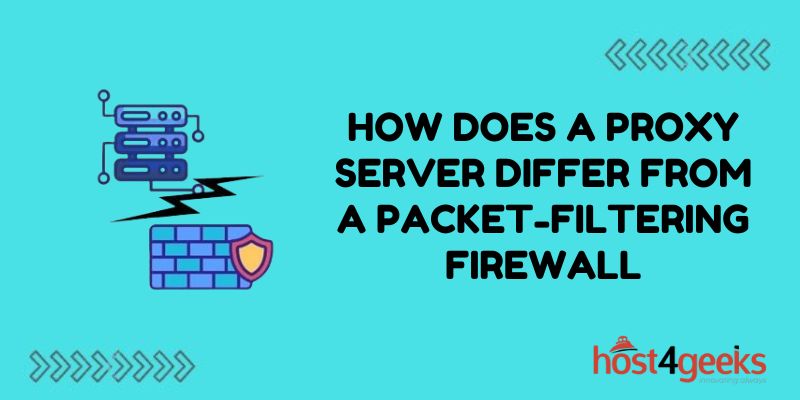A proxy server and a packet-filtering firewall are two important components of network security infrastructure. However, they serve different primary purposes. Understanding the key differences between a proxy server and a firewall is important for setting up an effective security strategy.
Overview of Proxy Servers
A proxy server acts as an intermediary between client devices and external servers. Proxy servers are situated between internal network clients and external sites, typically on the Internet. All client traffic gets routed through the proxy, which can manipulate requests and responses.
Some of the key functions of a proxy server include:
- Caching content for faster access
- Filtering access to certain websites
- Logging and auditing traffic
- Concealing IP addresses from external sites
- Load balancing between servers
Proxy servers focus more on controlling and optimizing access to web content and applications. They can improve performance, security, and access controls. However, most proxy servers do little in the way of advanced threat protection.
Overview of Packet-Filtering Firewalls
A packet-filtering firewall inspects traffic at the network layer and filters packets based on preset rules. The firewall examines source and destination IP addresses, protocols, and ports to determine whether to allow or block specific packets.
Packet-filtering firewalls focus primarily on permitting or blocking network access based on traffic attributes. They provide basic protection against unauthorized access and common network-based attacks. However, their access controls are relatively limited compared to more advanced firewall types.
Some key capabilities of packet-filtering firewalls include:
- Filtering traffic based on protocols, ports, IP addresses
- Guarding against IP spoofing and port scans
- Setting up basic network access rules between zones
- Inspecting outbound as well as inbound traffic
However, packet filters have notable limitations in dealing with encrypted apps and higher-level threats. Their access rules are also less flexible compared to proxy servers.
Key Differences Between Proxies and Packet-Filtering Firewalls
Now that we’ve covered the basic functions of proxies and packet filters, let’s outline some key differences:
Traffic Flow Inspection
Proxy servers inspect traffic at the application layer, while packet filters inspect at the network layer. This means proxies interpret the full context of requests, while packet filters just look at IP/protocol metadata.
Orientation
Proxies are oriented toward optimizing outbound network access, while firewalls focus on regulating inbound access. Proxies aim to enhance and secure connections to external sites. Firewalls lock down external entry points into internal networks.
Flexibility
Proxies can interpret application traffic contents to implement more advanced policies, while packet filters have predefined static rules. The application awareness of proxies allows for more context-based filtering.
Encryption Handling
Proxies can decrypt outgoing HTTPS traffic to inspect contents, while packet filters are limited in encrypted traffic analysis. The inbound/outbound orientation also affects encryption handling.
Caching and Load Balancing
Proxies can efficiently cache content and balance loads between servers, while firewall packet filters lack these optimization features. Caching and load balancing are unique proxy server strengths.
Endpoint Connections
Clients connect directly to proxy servers, while endpoints do not actively connect to the firewall. This highlights the intermediary nature of proxies versus the passive filtering of firewalls.
Proxy Server Advantages
Proxy servers offer notable benefits, including:
- Fine-grained access controls based on users, groups, URLs, content types, quotas
- Anonymization by hiding internal IP addresses
- Caching frequently accessed content to accelerate performance
- Bandwidth optimization by filtering unwanted content
- Improved availability through load balancing
- Malware filtering by blacklisting connections to known malicious sites
- SSL/TLS inspection of encrypted traffic in plaintext
Packet-Filtering Firewall Advantages
Packet-filtering firewall advantages include:
- Real-time protocol and port filtering to prevent network-based attacks
- Stateful inspection across multiple layers for better accuracy
- Efficient setup with preconfigured rule sets
- Constant vigilance against traffic anomalies and DoS attacks
- Multidirectional filtering of inbound and outbound connections
- Preserving network performance with lightweight packet inspection
- Support for next-gen rule types based on geolocation, reputation, and other factors
Key Takeaways on the Differences
In summary, there are some key high-level differences:
- Proxies optimize and control outbound access, and firewalls regulate inbound access
- Proxies operate at the application layer, firewalls at the network layer
- Proxies interpret content for flexible rules, packet filters have predefined rules
- Proxies facilitate additional services like caching, load balancing, and malware filtering
So in essence:
- Proxies = outbound optimization and flexible controls
- Firewalls = inbound access hardening and predefined rules
When to Use Proxies vs. Packet-Filtering Firewalls
Given their different strengths, here are some guidelines on deployment:
Use proxies when:
- You need to control and filter outbound internet access
- You want to cache content and accelerate performance
- You need flexible, content-aware access policies
- End users connect directly to external sites
Use packet-filtering firewalls when:
- You mainly need to regulate inbound access from untrusted zones
- You want constant monitoring against network attacks
- You need straightforward port/protocol filtering rules
- You have multiple untrusted networks to isolate
For the best security, many organizations implement both proxies and firewalls to take advantage of their complementary strengths.
Final Thoughts
Proxy servers and packet-filtering firewalls address distinct aspects of network security:
- Proxies secure and enhance outbound traffic flows
- Firewalls lock down inbound access points
By leveraging both technologies, organizations can optimize their connectivity while thoroughly hardening their network perimeter.
Understanding the key differences outlined here provides guidance on when to deploy proxies, firewalls, or both in developing a robust network security architecture.

